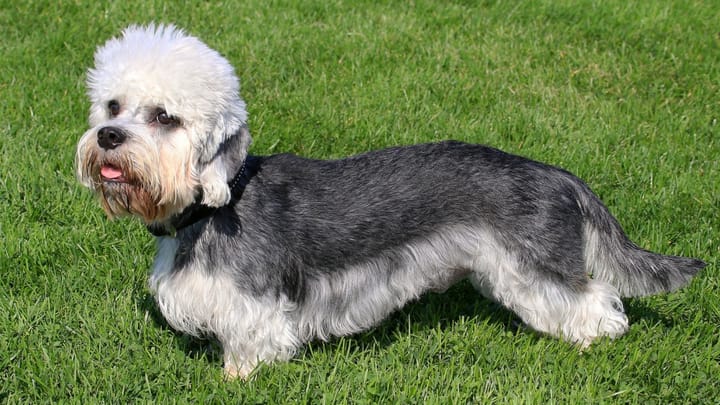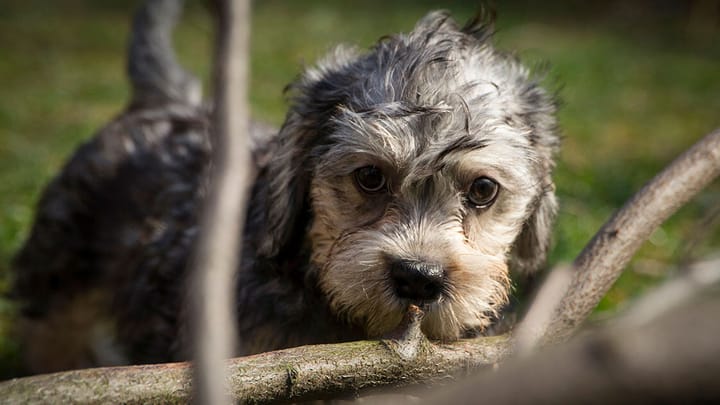Dandie Dinmont Terrier
Other names : Dandie, Hindlee Terrier, Charlie’s Hope Terrier, Mustard & Pepper Terrier


‘The gentleman of the terrier family,’ ‘the world’s oldest terrier,’ ‘Scotland's forgotten breed’ – the Dandie Dinmont Terrier has quite the reputation to those in the know. But it nearly came to nought as the breed dwindled towards extinction as recently as 2015-2016, before staging a mighty, yet incomplete, comeback. He’s long, very long like a sausage dog, covered in a double coat of which the top layer is not quite wiry, and he’s capped by a top-knot of silky hair like a little old lady. The Dandie Dinmont Terrier is really quite a fabulous fellow and it’s difficult to see how he has become such a troublingly rare breed.
|
Life expectancy |
The Dandie Dinmont Terrier has a life expectancy of between 12 and 14 years |
|
Temperament |
|
|
Size |
Small
|
|
Adult size |
Female
Between 10 and 12 in
Male
Between 10 and 12 in
|
|
Adult weight |
Female
Between 18 and 24 lb
Male
Between 18 and 24 lb
|
|
Coat colour
Pepper (dark blue-grey with silver-white topknot) or Mustard (reddish brown-pale fawn with cream-white topknot and darker feet/legs). |
Brown Blue |
|
Type of coat
The Dandie Dinmont Terrier's hair is medium length. Double coat : soft, lint-like undercoat and crisp (not wiry) overcoat. Feathered legs and a silky topknot. |
Long |
|
Eye colour
The Dandie Dinmont Terrier's eyes are dark hazel. |
Brown
|
|
Purchase price |
The Dandie Dinmont Terrier costs approximately 1000£ |
The Dandie Dinmont Terrier is rare among dog breeds for having his own tartan : a black and yellow variation given him by the Duke of Buccleuch.
More details about the Dandie Dinmont Terrier
Dandie Dinmont Terrier: Origins and history
We know of the Dandie from as far back as the year 1700, although he would not get his name until the 19th century, when novelist Sir Walter Scott created a character (in his novel “Guy Mannering”) based on the real life dog breeder James Davidson ; the character was named Dandie Dinmont, a farmer, and it is whispered that every modern Dandie can trace his lineage to Davidson’s real life terrier, Old Ginger.
In fact, Old Ginger has his own statue at Selkirk, where the dog was born. It’s possible the breed originated as a cross between a Scottish Terrier and a Skye Terrier.
The Dandie prevailed admirably over the years, his unique appearance aptly matched by his status as the only dog breed named after a fictional character ; Louis I of France had two of the fellows at his feet, and in 1875 the Dandie Dinmont Terrier Club (DDTC) was founded – today it is the third eldest breed club in the world.
However, by the turn of the latest century, the Dandie was in trouble, with barely two-dozen pups being registered per year (way below the 300 required to surpass ‘vulnerable’ status).
Thanks to campaigning efforts by those such as breeder Paul Keevil, pup numbers have risen modestly without reaching safety. The kennel building where Old Ginger was born is being restored as a Dandie ‘discovery centre’ and work is being done to raise the profile of this rather unknown dog who suffers from fashionability rather than any practical or aesthetic drawback.
Physical characteristics of the Dandie Dinmont Terrier
His long body and arched back soar past front legs that are little more than elongated feet before coming to a surprising conclusion : a bouffant hair-do (or ‘top-knot’) on his head. The Dandie’s seductive eyes are large and round and set quite far apart. His ears are pendulous and hang low, giving him the look of distinguished archivist. His black button nose caps a muzzle that barely got started. While he is proportionately built, that fabulous hairdo and beard add inches to his head, giving the impression that it has been swapped for that of a darling old man. While Robert Smellie’s famous painting of the breed appears to be somewhat naive and caricatured, it is a peculiar paradox of this breed that its appearance heeds Smellie’s description yet retains a sense of dignity at the same time. A dandy, indeed.
FCI classification of the Dandie Dinmont Terrier
-
Group 3 - Terriers
-
Section 2 : Small sized Terriers
Dandie Dinmont Terrier: Characteristics
Dandie Dinmont Terrier: Behaviour
Training a Dandie Dinmont Terrier
The Dandie is intelligent and keen to learn. However he can also be a bit stubborn and wilful. So an easy ride is not guaranteed.
Dandie Dinmont Terrier: Lifestyle
Breed compatibility Dandie Dinmont Terrier
Dandie Dinmont Terrier: Purchase price
The average price for a Dandie Dinmont Terrier dog is approximately £1000.
The Dandie Dinmont Terrier can cost around £25 - £35 per month to feed and maintain.
Dandie Dinmont Terrier: Shedding
Average
Shedding is moderate.
Dandie Dinmont Terrier: Grooming
The Dandie Dinmont Terrier requires his dead hair to be stripped a couple of times each year, plus daily brushing, and the regular nail-clipping and ear maintenance afforded to most dog breeds.
Dandie Dinmont Terrier: Health
12-14 years
Trust his facial expression, not his size : this is a hardworking and durable little fellow.
His tolerance for the heat is so-so ; as with any dog, give him plenty of shade and water and don’t leave him unattended in a car.
He’s Scottish, after all. The Dandie Dinmont Terrier doesn’t mind a bit of weather, though he does not expect to be kept outdoors overnight.
The Dandie does not particularly tend towards obesity, so long as an appropriate dietary and exercise regime are maintained.
- Hip or elbow dysplasia
- Primary glaucoma
- Intervertebral disc disease
- Portosystemic shunt
- Cushing’s disease
- Bladder stones
Do you want a Dandie Dinmont Terrier dog ?
Oh no...
There are no Dandie Dinmont Terrier adoption profiles at the moment...





